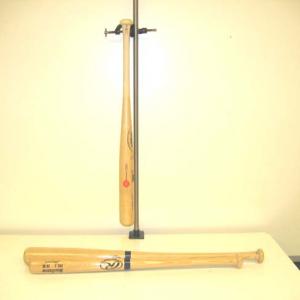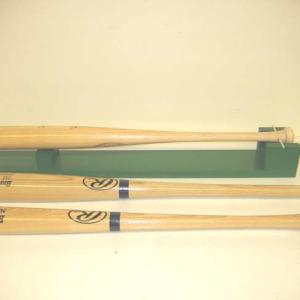College of Liberal Arts & Sciences
3A15.50 - Center of Percussion - Baseball Bat
Place the desired bat on the support with the correct length pendulum. They will swing in unison when the length of the pendulum is the same as the center of mass of the bat. This can be marked on the bat.
The center of percussion of the bat can be found by placing the bat into the testing apparatus using a balsa wood splint for the pivot. Lift the bat slightly and drop it onto the small block. If you have found the center of percussion, the balsa wood splint will survive intact. If not, there will be a torque on the end of the bat that will break the splint.
- Yau-Jong Twu, "From Rolling Without Slipping to Sweet Spots", TPT, Vol. 58, #3, Mar. 2020, p. 218.
- David Kagan, "The Vibrations in a Rubber Baseball Bat", TPT, Vol. 49, #9, Dec. 2011, p. 588.
- Dan Russell, "Swing Weights of Baseball and Softball Bats", TPT, Vol. 48, #7, Oct. 2010, p. 471.
- Rod Cross, "A Double Pendulum Swing Experiment: In Search of a Better Bat", AJP, Vol. 73, #4, Apr. 2005, p. 330.
- Rod Cross, "The Sweet Spot of a Baseball Bat", AJP, Vol. 66, #9, Sep. 1998, p. 772.
- Howard Brody, "Models of Baseball Bats", AJP, Vol. 58, #8, Aug. 1990, p. 756.
- H. Brody, "The Sweet Spot of a Baseball Bat", AJP, Vol. 54, #7, July 1986, p. 640.
- George W. Ficken, Jr., "Center of Percussion Demonstration", AJP, Vol. 44, #8, Aug. 1976, p. 789.
- Matt Goulet, "How a Major League-Worthy Louisville Slugger Gets Made", Popular Mechanics, Vol. 192, #7, July/Aug. 2015, p. 54.
- D. Rae Carpenter Jr. and Richard B. Minnix, "M-694. Sweet Spot on Bat", DICK and RAE Demo Notebook, 1993.
- Jodi and Roy McCullough, "Inertia with a Power Bat", The Role of Toys in Teaching Physics, p. 4.100.
- Borislaw Bilash II and David Maiullo, "Standing Waves of a Baseball Bat", A Demo a Day: A Year of Physics Demonstrations, p. 214.
- "The Sweet Spot on a Baseball Bat", The Caliper, Fall 2010, p. 9.
- Jearl Walker, "1.23. Hitting a Baseball", The Flying Circus of Physics Ed. 2, p. 10.
- Jearl Walker, "1.23. Hitting a Baseball", The Flying Circus of Physics, p. 10.
- Harvard University Extension School, "Principles of Physics 1: Mechanics--Expt. The Sweet Spot".
- Borislaw Bilash II, “A Sweet Bat“, A Demo A Day – A Year of Physical Science Demonstrations, p. 252.
- Julius Sumner Miller, Q224 & A224, Millergrams II – Some More Enchanting Questions for Enquiring Minds, p. 69 & 117.
Disclaimer: These demonstrations are provided only for illustrative use by persons affiliated with The University of Iowa and only under the direction of a trained instructor or physicist. The University of Iowa is not responsible for demonstrations performed by those using their own equipment or who choose to use this reference material for their own purpose. The demonstrations included here are within the public domain and can be found in materials contained in libraries, bookstores, and through electronic sources. Performing all or any portion of any of these demonstrations, with or without revisions not depicted here entails inherent risks. These risks include, without limitation, bodily injury (and possibly death), including risks to health that may be temporary or permanent and that may exacerbate a pre-existing medical condition; and property loss or damage. Anyone performing any part of these demonstrations, even with revisions, knowingly and voluntarily assumes all risks associated with them.

